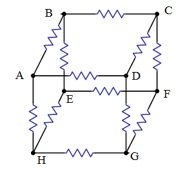Embibe Experts Solutions for Chapter: Current Electricity, Exercise 1: Exercise
Embibe Experts Physics Solutions for Exercise - Embibe Experts Solutions for Chapter: Current Electricity, Exercise 1: Exercise
Attempt the free practice questions on Chapter 3: Current Electricity, Exercise 1: Exercise with hints and solutions to strengthen your understanding. Physics Crash Course (Based on Revised Syllabus-2023) solutions are prepared by Experienced Embibe Experts.
Questions from Embibe Experts Solutions for Chapter: Current Electricity, Exercise 1: Exercise with Hints & Solutions
Which direction is taken as the convention direction of current?
What is the relationship between potential difference across the terminals of a cell and emf of the cell in an open circuit?
Find the number of free electrons in a copper wire of length and cross sectional area . Determine the charge carried by these free electrons. Number density of free electrons in copper is per .
Two conductors, one having resistance R and another are connected in turn across a d.c. source. If the rate of heat produced in the two conductors is and respectively, what is the value of ?
Two heater coils made of same material are connected in parallel across the mains. The length and diameter of the wire of one of coils are double that of the other. Which one of them will produce more heat?
What is the effect of heating of a conductor on the drift velocity of free electrons?
Twelve resistors each of resistance are joined to form a cube as shown in the figure given below. Find the equivalent resistance between the diagonally opposite points and .

A resistor and a resistor are connected in parallel. The combination is connected to a cell in one side and a rheostat in another side. The sliding contact of rheostat is connected to the other terminal of the battery through an ammeter. Find the maximum and minimum value of current in the circuit. Neglect the internal resistance of the cell.
